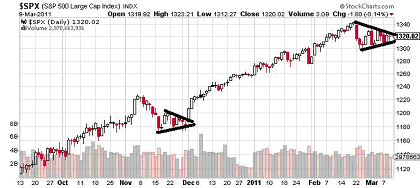The S&P 500 is setting up for a decisive move
in the next few days. Problem is, it’s impossible to tell which way it
will head. That’s what happens when a “pennant” formation occurs.
A pennant formation occurs after a large move for
an index or stock. Could be after a rally, could be after a sell-off. A
pennant is a series of lower highs and higher lows. It’s a sign of
indecision, and it usually resolves itself with a sharp move, one way or
the other…

I hope you’ll forgive my rudimentary graphics
skills, but technical patterns like a pennant are better seen than
imagined.
As you can see, I’ve highlighted a pennant on the
S&P 500 from late November (that broke to the upside) as well as the
one the index is currently in. It’s usually recommended not to trade a
pennant before you see which way it breaks, because the breakout move is
usually quick. And if you’re wrong, you’ll lose money, and you’ll miss
the strongest part of the breakout. Double whammy.
*****As you know, I’ve started to refer to the
recent weakness in stocks as a consolidation instead of a correction. But
that doesn’t mean that stocks can’t drop below support at 1,301 (on the
S&P 500) and as Jason Cimpl of TradeMaster
Daily Stock Alerts informed his readers this morning head
for 1,280 or even 1,250.
Another spike in oil prices could easily send
stocks reeling, for instance. At the same time, a sharp drop for oil
prices could send stocks ramping higher.
It’s pretty clear that there is a certain amount
of indecision among investors, and that indecision is playing in the
stock market as that pennant formation on the S&P 500.
*****The bond guru, Bill Gross of PIMCO, told us
that the 30-year bull market for Treasury bonds was over. He wasn’t
kidding, either. It’s being reported that Gross has sold off all of his
Treasury holdings, thank you very much Ben Bernanke.
Gross has been adding higher yielding emerging
market debt. He’s also adamant that inflation will become a bigger deal
in the U.S. than it is right now. Plus, the Fed’s bond-buying program,
QE2, will end in June.
If you haven’t moved out of Treasuries and into
better yielding assets, there is still time…
*****We’ve been talking about the weakness of
China’s economy as it struggles to contain inflation. Today, China
reported that it actually ran a $7.3 billion trade deficit in February.
That’s right, deficit. As in: more money going out than coming in. It’s
the first one in 7 years. And higher commodity prices appear to be the
culprit.
This may put the “revalue the yuan” rhetoric on
hold. But more importantly, it highlights the imbalances of the Chinese
economy. To keep its export economy churning and support its own growth,
China must be a steady buyer of commodities, including food. And China
can’t stop, even as prices rise.
China’s central government has talked about what
needs to change — domestic consumption and economic activity needs to
improve. But that can’t happen as long as the Chinese economy is
dominated by inefficient state-run enterprises.
Exactly how different is this from “too big to
fail” banks here in the U.S.?
*****Oil prices are down this morning, even though
the situation in Libya is getting worse. This could mean that traders
believe the conflict is nearing an end. Or it could mean that traders are
raising cash as the financial markets become more uncertain.
Let’s not forget, the stock market does not like
uncertainty.
 Facebook
Facebook
 Twitter
Twitter